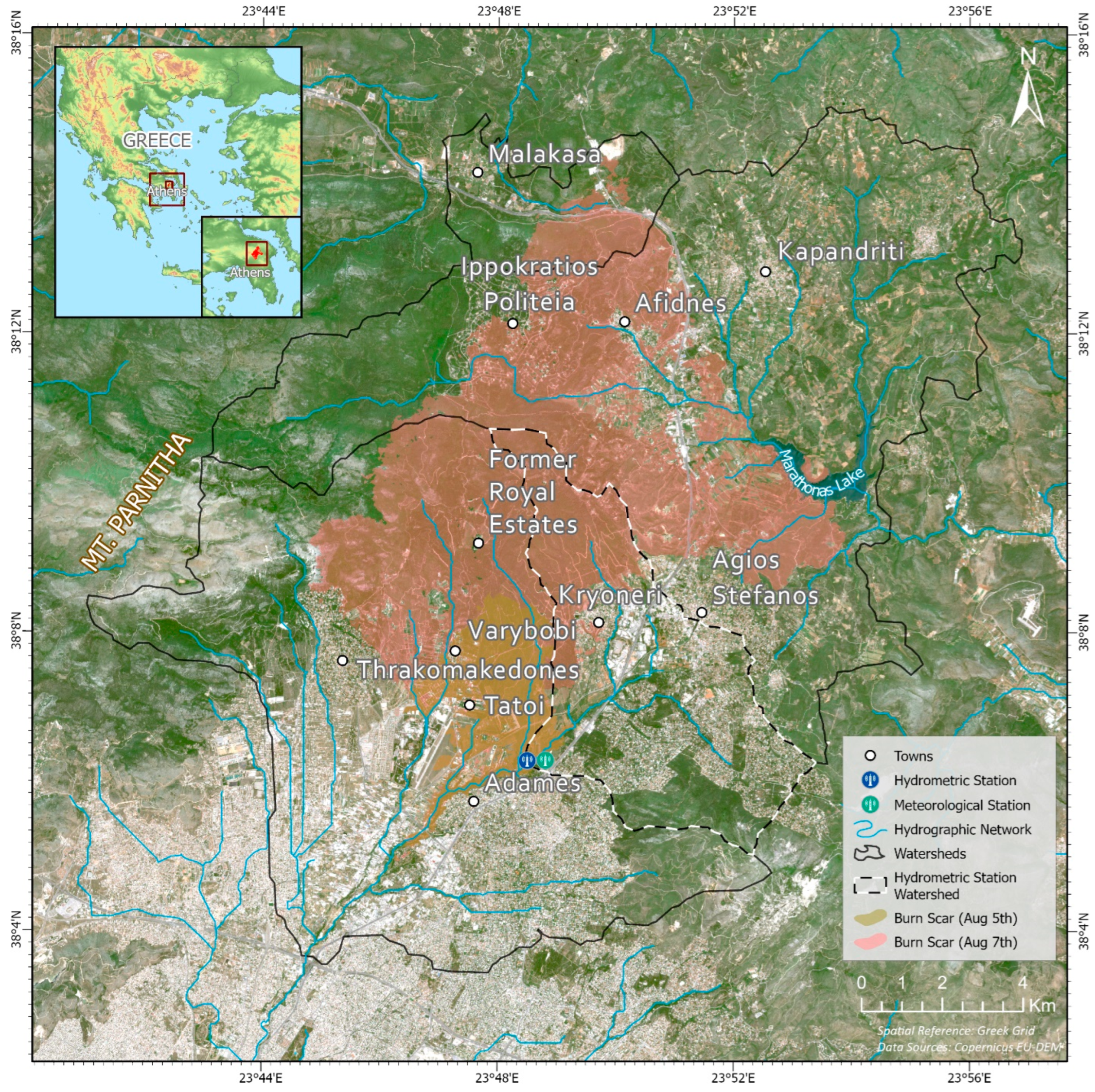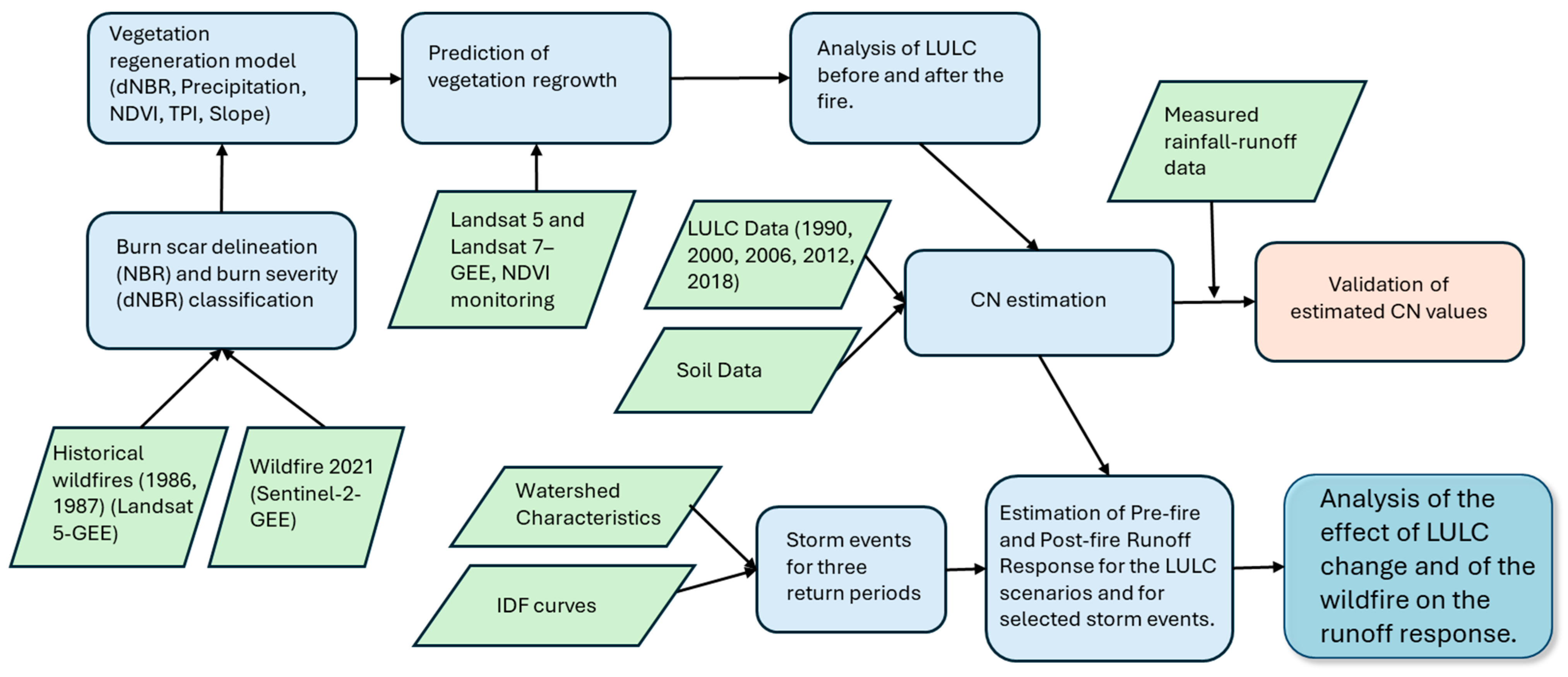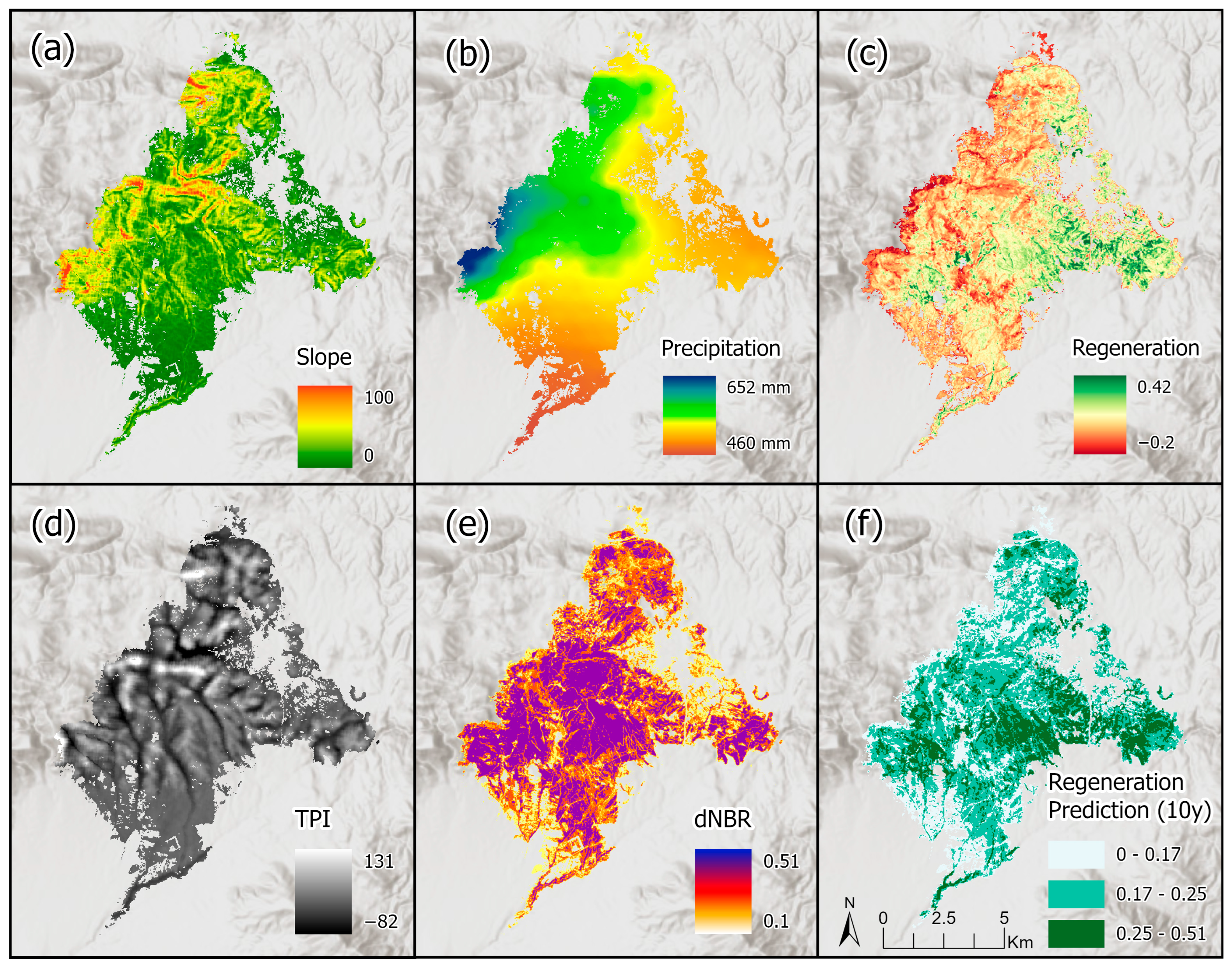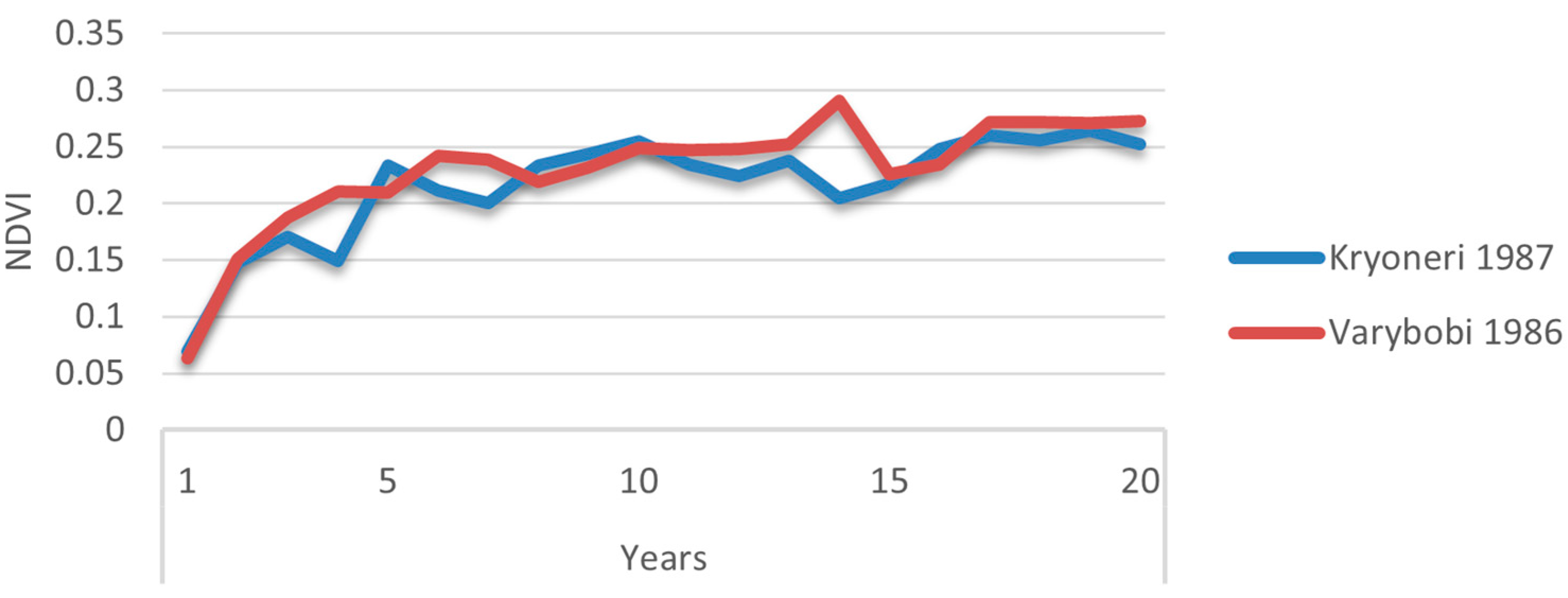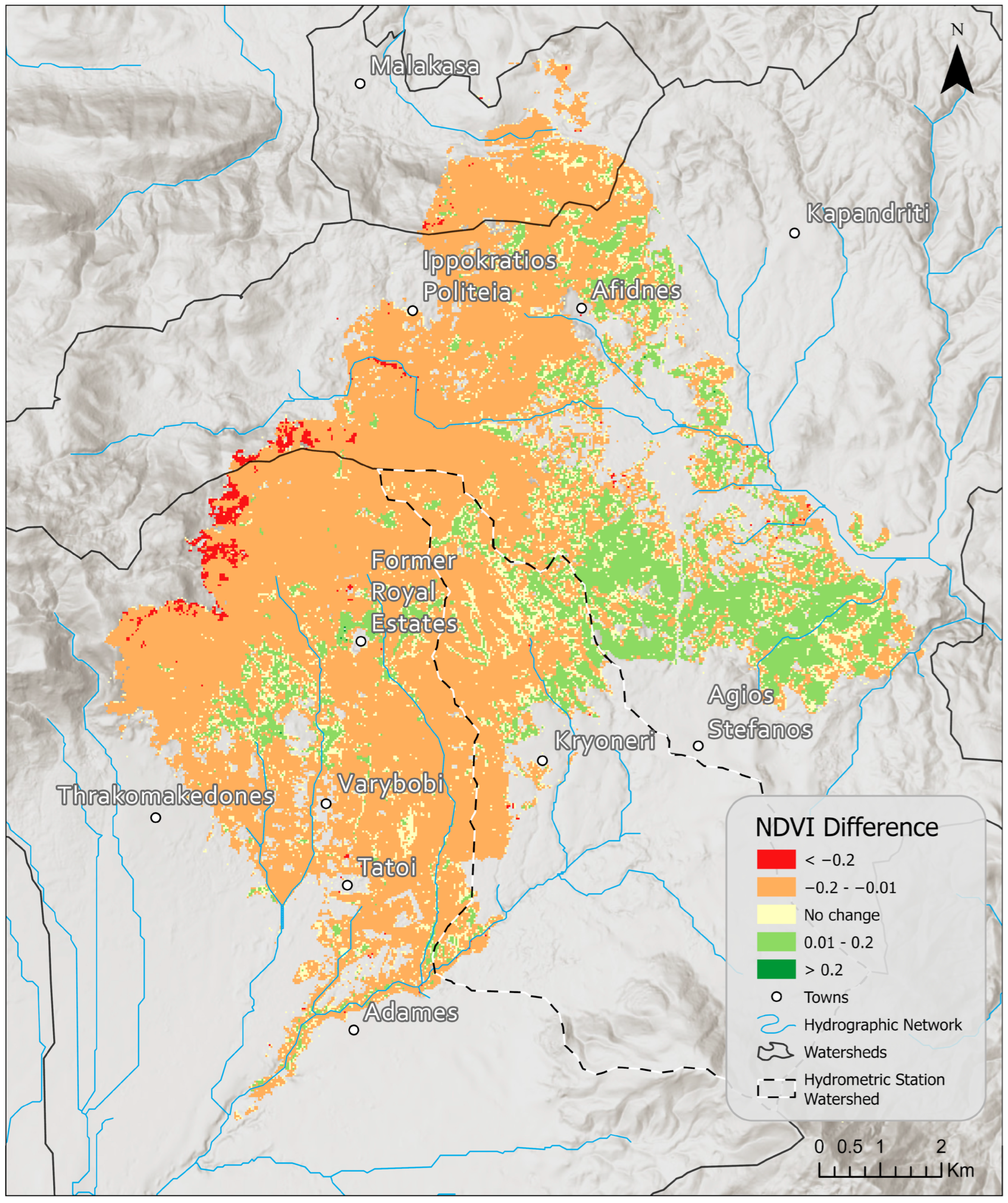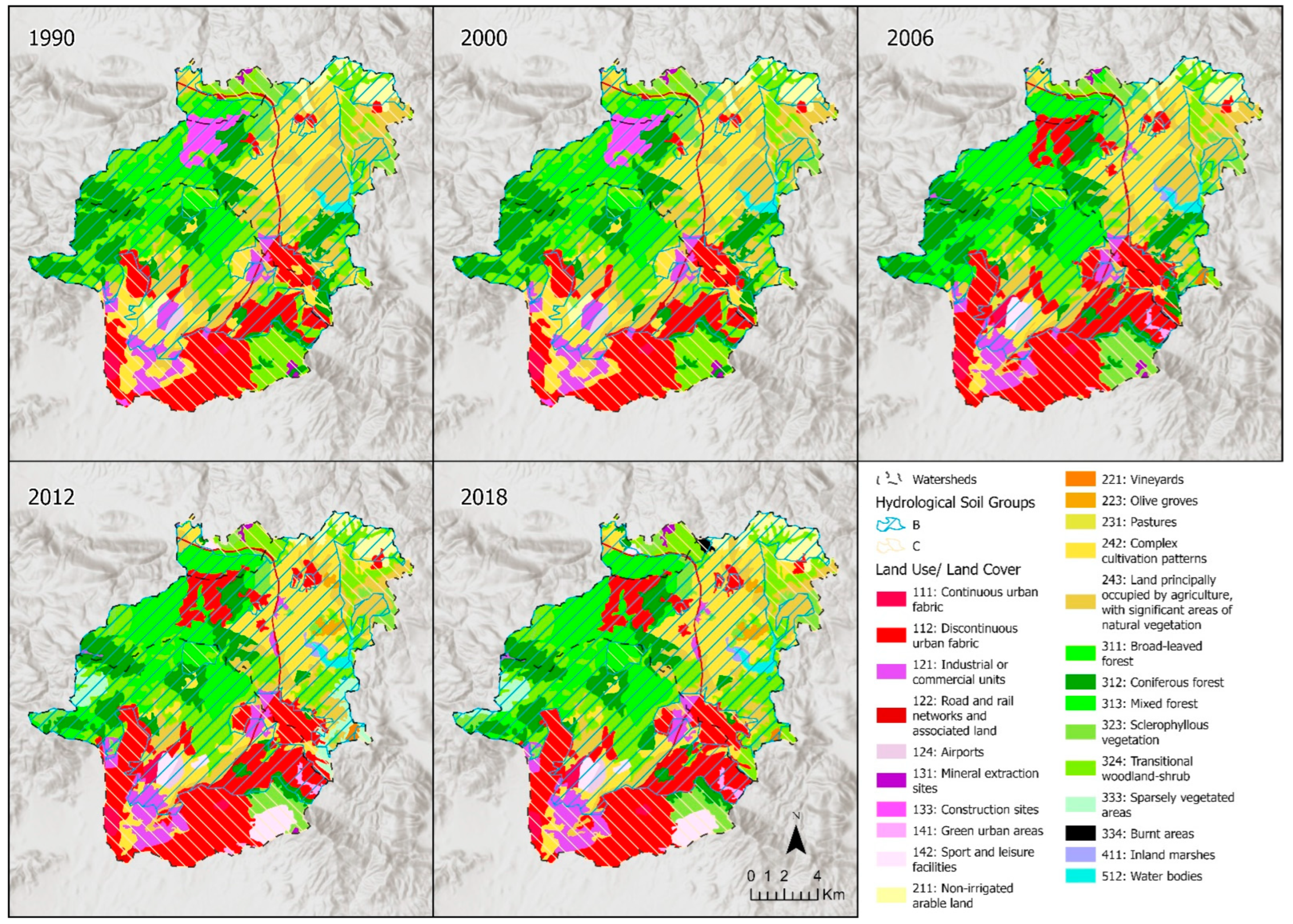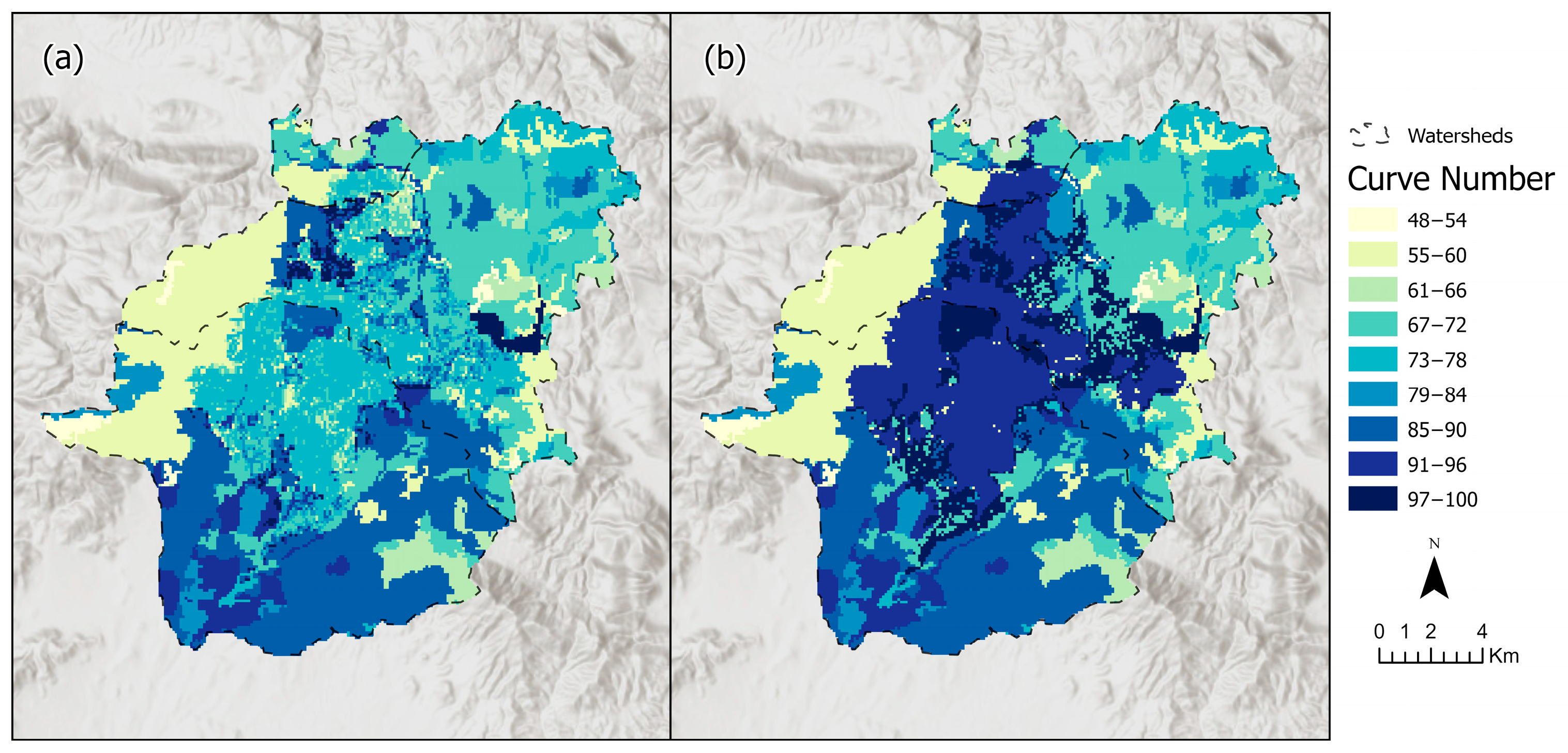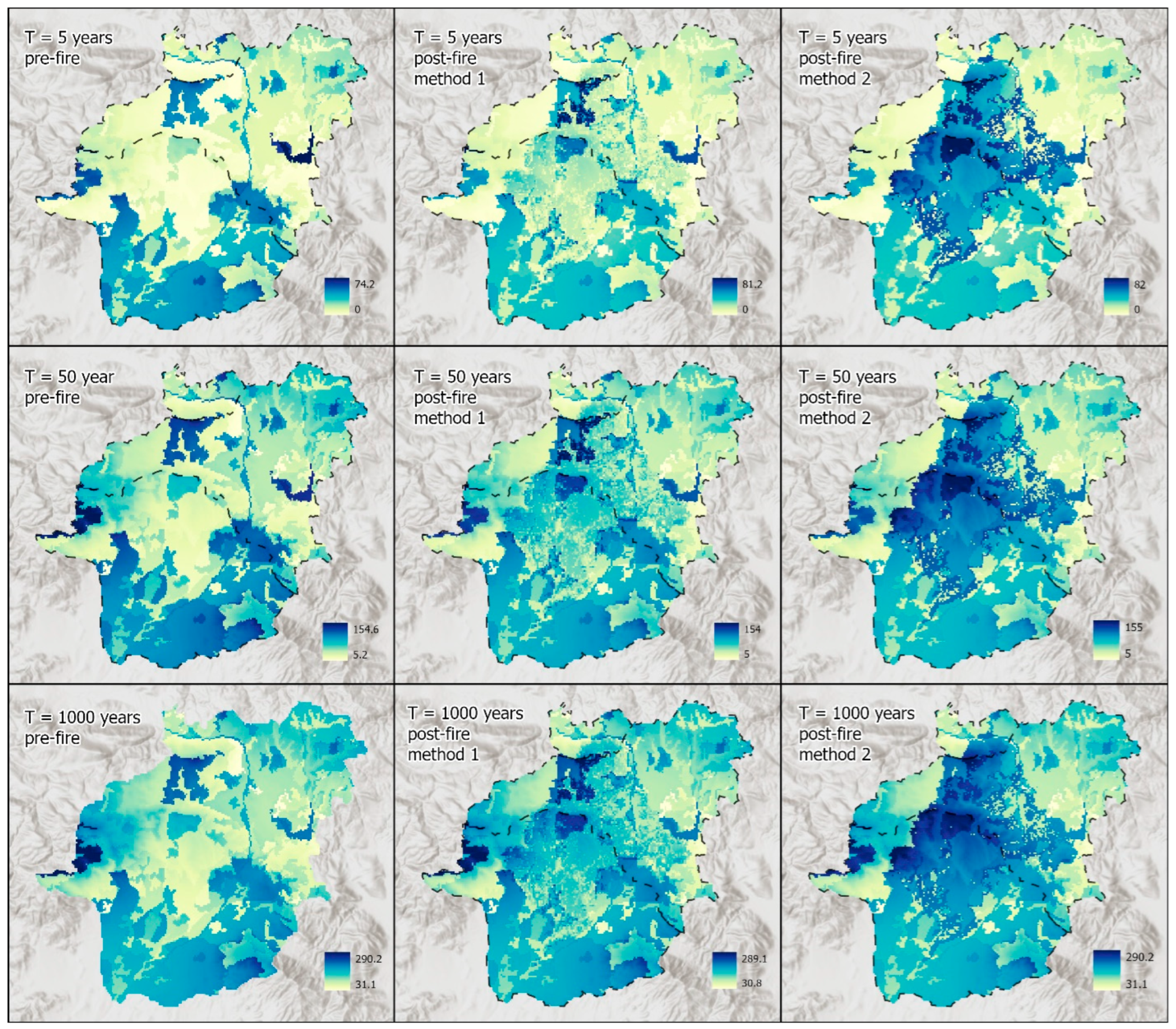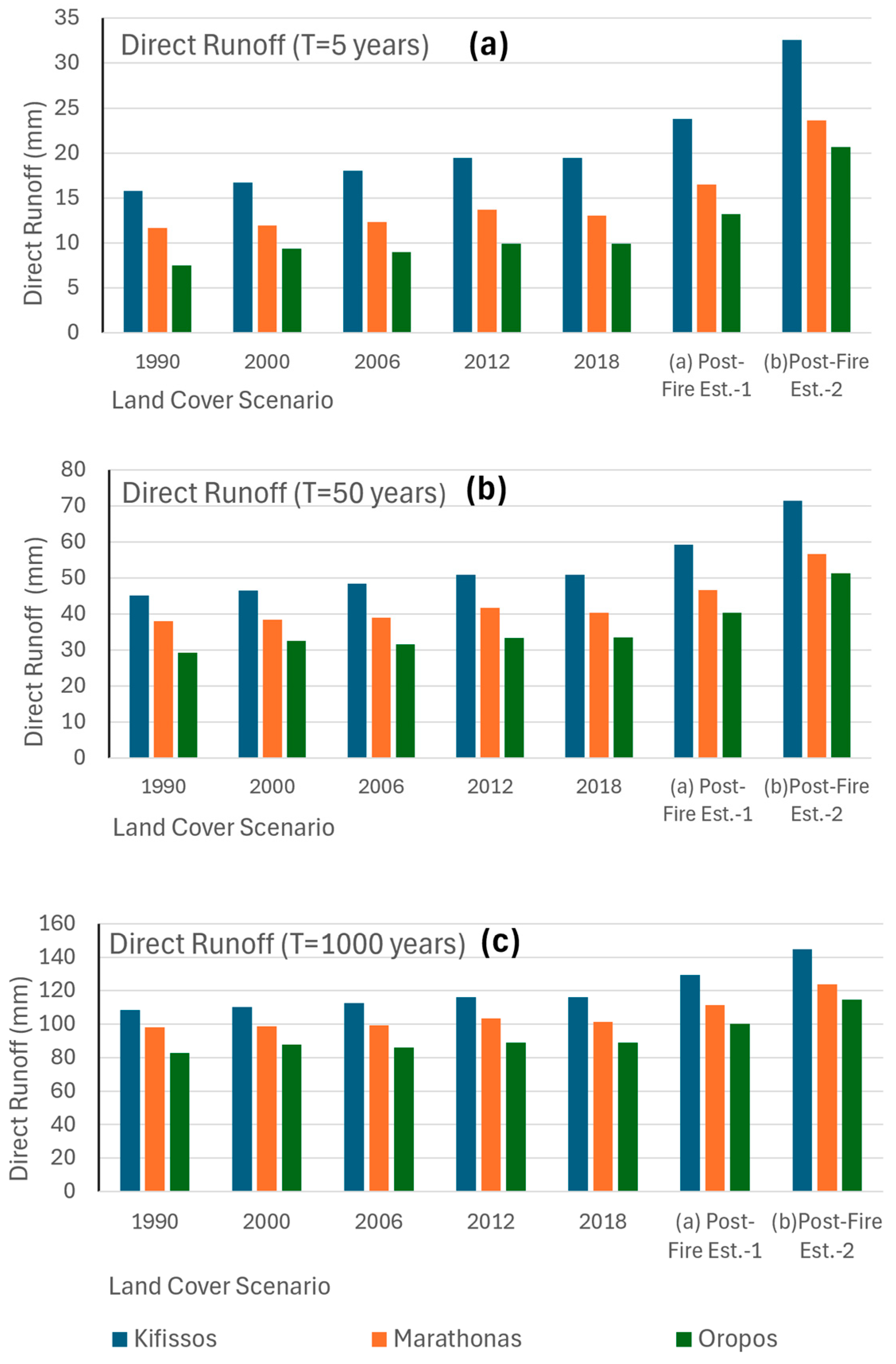1. Introduction
Forest fires are an integral part of the Mediterranean ecosystem, where the phenomenon has intensified in recent years, as a result of societal and climate changes [
1,
2]. Wet and mild winters contribute to the accumulation of fuel load, which becomes flammable in the summer due to high temperatures, little to no rainfall, and overall low humidity [
3,
4]. At the same time, fires in Mediterranean ecosystems are a key natural process of vegetation renewal and nutrient recycling. However, the consequences provoked when the phenomenon intensifies are the reduction of soil fertility, the destruction of forested land and the degradation of the landscape and the ecosystem [
5,
6]. Additionally, wildfires pose a significant threat to people and their activities, as their destructive nature leads to loss of human life and property [
7,
8].
The effect of wildfires on soil properties depends on many factors, such as soil characteristics, vegetation characteristics and fuel availability, geomorphological characteristics, fire characteristics, and meteorological conditions prevailing during and after fires. Wildfires affect soil hydraulic properties in various ways, such as (i) destroying organic matter in the upper soil layer and disrupting its structure, (ii) causing soluble ash to cover soil particles, making them water repellent, and (iii) under the combined influence of rainfall, crust is formed on the soil surface [
9,
10,
11,
12,
13,
14,
15]. In addition, extensive wildfires affect the hydrological behavior of natural watersheds. In Greece and, by extension, in the Mediterranean region, the problem of wildfires significantly affects the hydrological behavior of watersheds, as storm events are of short duration and high intensity and the summers are hot and dry. For the investigation of flood risk, separate parameters related to the meteorological and hydrological conditions, the geomorphology of the area, land use conditions, and anthropogenic interventions must be considered. Changes in the hydrologic regime are directly linked to the destruction of soil vegetation, which results in a reduction in rain interception by plants and thus an increase in surface runoff [
16,
17,
18,
19,
20,
21,
22]. In addition to the absence of vegetation cover, wildfires also affect hydrologic functioning indirectly by altering the hydraulic properties of the soils, causing a reduction in water penetration capacity and, at the same time, soil erosion is caused [
23,
24,
25,
26]. Folador et al. [
27] found that a severe storm at a burned watershed leads to increases in flood peak and runoff volume by up to 125% and 75%, respectively. Soulis et al. and Soulis [
25,
28], on the Lykorrema watershed on Mt. Penteli (Greece) after a catastrophic wildfire in 2009, revealed that, post-fire, the direct runoff depths and the peak flows increased by more than 7.7 and 11.8 times, respectively.
In the same watershed, Soulis [
28] investigated the change in Soil Conservation Service Curve Number (SCS-CN) main parameter CN in burned conditions based on measured rainfall–runoff data before and after the fire. The study revealed that, post-fire, the hydrological basin response turned from complacent to standard and the estimated values of the CN parameter for the studied soil–land cover complexes increased by 25 units on average. Further, Soulis et al. [
22] observed a profound reduction in the actual evapotranspiration and an increase in water yield and percolation in post-fire conditions. A noticeable increase in sediment yield was also observed. Psomiadis et al. [
29] explored the effect of both wildfires and urbanization on direct runoff at a watershed in Attiki, Greece using the SCS-CN method. They concluded that urbanization contributes to a higher increase in runoff than wildfires, but the two variables combined lead to even higher values.
The recovery of hydrological functioning to pre-fire conditions requires a period that depends on the rate of vegetation recovery [
30]. According to previous studies, this period is related to the type of vegetation that existed before the fire. Also, it has been established that the amount of plant cover is a key factor in reducing post-fire runoff and soil erosion, as well as accelerating the recovery time for burned soils [
31,
32,
33,
34,
35,
36,
37]. Other factors affecting the post-fire recovery process are burn severity, climate, management, water shortage and harsh meteorological and hydrological conditions, steep relief, highly erodible soils, silvicultural treatments, grazing etc., [
38,
39,
40,
41]. All these factors contribute to the amplification of the spatial and temporal variability in soil hydraulic properties [
42]. The burn severity and the extent of the burned area in the case of forest fires are critical factors in the analysis of their effect on the hydrological response of affected areas yet ascertaining them involves very difficult and laborious field work. Depending on the prevailing conditions, the restoration period can last from 1 or 2 years after the wildfires to up to 5 or even 10 years [
31,
33,
43,
44,
45]. As an example, Soulis [
28] observed increased runoff depths 4–6 years after the fire. Remote sensing is a widely used method for continuously monitoring vegetation and assessing its characteristics, such as its biomass, cover density, vigor, aquatic stress, etc. Using data from satellite and airborne sensors operating at various spatial and spectral resolutions, remote sensing enables large-scale vegetation assessments over time.
Since the 1990s, there has been a steady increase in international publications related to the use of remote sensing for studying wildfires, which has been even more profound during the last 5 years [
7,
29,
46]. With technological development and the large availability of data, their processing through remote sensing techniques and Geographical Information Systems (GIS) software locally requires powerful computing systems. Therefore, cloud systems are starting to significantly outperform local processing. The Google Earth Engine (GEE) platform is currently used quite extensively for the processing and analysis of large amounts of geospatial data in a cloud environment [
30,
47].
More specifically, GEE, created in 2010, is an online platform of GIS that uses cloud technology (therefore without the need for powerful local hardware to process the data) with two aims; on one hand to make large amounts of satellite remote sensing data available, implementing European open access policies, and on the other hand, the development of a multitude of applications satisfying many research needs through its programming environment. Google’s data files include both satellite imagery and vector datasets, social, demographic, weather, and climate layers, as well as digital terrain models. The main categories of applications addressed are vegetation mapping and monitoring, land cover mapping, agriculture, and disaster management [
47,
48,
49].
Research on post-fire vegetation recovery in Mediterranean climates focuses on understanding the ecological processes and factors that influence post-fire regeneration, including the role of fire severity, climate conditions, plant traits, and landscape characteristics [
30,
50,
51,
52,
53,
54,
55]. Previous studies have typically used a combination of field measurements, remote sensing, and modeling approaches to assess post-fire vegetation recovery patterns, identify key drivers, and inform post-fire management strategies [
56]. Meneses [
53] in his study about wildfires in Portugal, suggests that factors affecting regrowth are vegetation type, soil, climate, and continentality. Aguiar et al. [
52] found that burn severity had no impact on the composition of flora or its richness on the stage of post-fire regrowth. Wilson et al. [
56] modeled post-fire ecosystem recovery using satellite-derived observations of vegetation as a function of stand age, topography, and climate. Most other studies have assessed vegetation regrowth by using spectral indices and comparing their diachronic evolution with pre-fire conditions [
49,
57,
58].
In view of the above, the present study develops a GIS-based method integrating remote sensing techniques, vegetation recovery modeling, and hydrological modeling to analyze the effect of wildfires on runoff response and to predict the hydrological functioning recovery period. To this end, the 2021 wildfire in Varybobi, northern Attica, Greece, is used as an example. First, the wildfire’s burn scar is delineated, and the subsequent burn severity is calculated and mapped. Then, a regression model is created to estimate vegetation regeneration based on the analysis of historical forest fires in the study area, as well as other topographic and climatic variables. Subsequently, based on this information, the effect on the hydrological behavior of the affected area is systematically analyzed and the period required for the restoration of the hydrological response is then estimated based on the developed vegetation regrowth models. The proposed method leverages a comprehensive set of remotely sensed data coming from various platforms, along with topographic data, land cover and soil spatial datasets, hydrological monitoring data, and field observations.
3. Results
3.1. Burn Severity
The total burned area of the August 2021 Varybobi fire, calculated using the dNBR index, is 8090 ha, with the spatial distribution of dNBR index values illustrated in
Figure 4e. Low severity burned areas make up 1251 ha of the land, the medium-low, medium-high and high severity classes cover 1373 ha, 2146 ha, 3308 ha, respectively.
The main land cover class of the CLC 2018 that is found within the burned area is forest, which covers 5570 ha and includes a. transitional woodland–shrub (1982 ha, 24.5% of the total area), b. mixed forest (1768 ha, 21.9%), c. coniferous forest (1227 ha, 15.2%), and to a lesser extent, d. broad-leaved forest (357 ha, 4.4%) and e. sclerophyllous vegetation (235 ha, 3%). The remaining 2520 ha include artificial surfaces (772.7 ha, 9.5%), agricultural areas (1714.6 ha, 21.2%), and inland marshes (28 ha, 0.4%). Additionally, the high burn severity class covers mostly the forest land cover classes. In these areas, the vegetation was annihilated, leaving the ground bare.
The high dNBR values, indicating severe burn severity, are found throughout the burned area but are more pronounced in its interior. This pattern is largely influenced by land cover, as the most severely affected regions correspond to dense forested areas, where continuous fuel availability allowed for sustained fire spread and intense burning. In contrast, lower severity areas are more scattered and often correspond to agricultural zones or artificial surfaces, where reduced fuel continuity limited fire propagation.
3.2. Vegetation Regrowth
The regeneration of vegetation following the wildfires of 1986 and 1987, is demonstrated through NDVI changes in a 25-year-span (
Figure 5). During the first five years the increase in vegetation appears to be rapid, in contrast with the following decades when the increase stabilizes at a much lower rate.
The Pearson correlation test performed between the variables shows weak to moderate positive correlations, except for the TPI index, which shows a negative correlation with all the variables (
Table 3). The only exception is the relationship between slope and precipitation, which is at the lower values of strong correlation as higher slopes are mostly present at higher elevations (0.545).
Applying the linear multiple regression methodology for three time periods (5, 10, and 15 years after the fire), the R2 coefficient reached marginally acceptable levels for the first 5 and 15 years of regrowth (R5y2 = 0.6, R15y2 = 0.5). On the contrary, the linear regression for the 10-year vegetation regeneration presents a stronger correlation with R10y2 = 0.72. Accordingly, the developed models can be used for the prediction of vegetation regeneration and especially for the period after the first 10 years when vegetation growth has been stabilized.
In addition, a multicollinearity test of the independent variables was carried out for the multi linear model for the 10 years period, using the Tolerance and Variance Inflation Factor (VIF) indices. These indices resulted in values greater than 0.2 for Tolerance and less than 10 for VIF, proving the lack of multicollinearity between the variables (
Table 4). In addition, all variables are statistically significant, presenting probability (
p-value) values of less than 0.05 (
Table 5). Regarding the ANOVA test, the results of the analysis (
Table 6) suggest that the means of the severity categories are statistically significant (
p-value = 0).
The developed vegetation regeneration model was applied to the 2021 Varybobi wildfire area to estimate natural vegetation regeneration over the next 10 years with NDVI values. The spatial distribution of each variable used in the calculation is shown in grid form (
Figure 4). The synthesis of the equation represents the estimate of the increase in the NDVI index of the burned area for 2031.
According to the assessment model, there are areas where natural regeneration will be reduced in the next decade and will not reach the level of their pre-fire state. The difference between the pre-fire NDVI index (2021) and the predicted index 10 years after the fire (2031) is illustrated in
Figure 6. The areas with limited vegetation regrowth are located mainly in the western parts, while full development and/or increase is in the cultivated and the plain areas in the east. Significant reduction in the regeneration potential seems to be located at higher elevations and increased slopes. Specifically, 70.6% of the affected area is predicted to have similar NDVI values to the pre-fire period, 23.8% will have lower NDVI values by as much as −0.2, and 0.4% will have much lower NDVI values by as much as −0.44. On the other hand, 5.2% of the affected area is predicted to have increased NDVI values by as much as +0.25.
3.3. Hydrological Analysis
The area affected by the 2021 wildfire (
Figure 1) belongs to three main watersheds. The watershed of the Kifissos in the south, the watershed that ends up in Marathonas Lake in the east and, finally, a small watershed upstream of Oropos in the north. The water streams of the respective watersheds start from the Parnitha massif. The watersheds of the Oropos region, the Kifissos river and the Marathonas Lake, which also constitute the study area, cover a total area of 14.30 km
2, 146.69 km
2, and 130.64 km
2, respectively. These watersheds are mainly mountainous with significant slopes and have average elevations of 393.53 m, 442.91 m, and 437.28 m, respectively.
The hydrological soil groups prevalent in the study area are the B and C, namely, and most of the area is covered by relatively permeable soils with medium basic permeability and medium-to-light texture. A smaller part of the area is covered by soil with low basic infiltration and permeability, which is medium-to-heavy in texture. The soil–land cover complexes emerged for the different CLC years of reference (
Figure 7).
CN values range from 48 for highly permeable areas to 98 for nearly impervious surfaces. The higher values between 98 and 100 represent impermeable areas and water bodies (i.e., Marathonas Lake). The greater part of the basin is characterized by relatively small to moderate CNs, as can be seen in the detailed CN value ranges (
Figure 8). It is also found that the highest CN values appear in mainly urbanized areas, while the areas characterized by higher CN increase over the years due to urbanization.
Figure 9 depicts the post-fire CN ranges after applying the two methodologies described in the methodology section, using as a base the most recent CLC of 2018. The Curve Number values for the unburned areas remain unchanged as the LULC and hydrological properties of the soil remained unaffected. On the contrary, the CN values in the affected areas have increased significantly, with a larger increase appearing with the second methodology. Additionally, it can be observed that the CN values in the burned areas are like those of the built-up areas. Comparing the CN values in
Figure 8 and
Figure 9, it can be observed that the abrupt land cover change caused by the wildfire is much more profound than the gradual change due to urbanization.
The direct runoff (Q) was estimated for the three return-period scenarios using the two methodologies and the 2018 CLC as a reference year (
Figure 10). As a general note, what can be observed is an increase in the Q values post-fire in both methodologies suggests reduction in permeability in the burned areas. Similarly for the CN, the second method implies a much higher increase in the Q values in comparison with the first method.
A gradual increase is observed in the runoff volume from 1990 to 2018 due to the urbanization of the area and especially at lower elevations (
Figure 10). The effect of the fire, however, causes a sharp and noticeable increase in the volume of runoff which can lead to an increase in the flood hazard. The increase is evident from both methods of estimating the effect of the fire, with the larger one estimated by the method of Soulis [
28]. Specifically, this increase is presented in detail in
Table 3,
Table 4 and
Table 5. As an example, for the Kifissos River watershed and for a recovery period T = 50 years, the rate of increase in runoff volume compared to that before the fire is 16.6% by applying the methodology of Higginson and Jarnecke [
80], while with the methodology of Soulis [
28], it reaches 40.5% (
Figure 11,
Table 7).
3.4. Comparison with Actual Measured Data
As described in the hydrological analysis methodology section, the SCS-CN direct runoff estimations were based on CN values approximated using tables based on the watershed characteristics, while the post-fire CN values were calculated according to Higginson and Jarnecke [
80] (method 1) and according to Soulis [
28] (method 2). The post-fire direct runoff values estimated with the CNs obtained by the two examined methods are plotted in comparison with the observed direct runoff response in
Figure 12. As can be seen, both methods predict the post-fire direct runoff with reasonable accuracy considering the limited number of recorded events and the high scatter in the runoff response observed. The first method seems to be more conservative in runoff estimation providing better predictions for most events with lower runoff response, while method 2 estimates higher runoff estimations for the same rainfall depths and its predictions fall near to the most extreme events in terms of runoff response.
Regarding the CN values estimated from observed rainfall-runoff data with corresponding CN values with the Two-CN method [
14] were CN1 = 91.4, covering 31.7% of the watershed, and CN2 = 45.6, covering 68.3% of the watershed (
Figure 3). The corresponding values obtained by spatially averaging the post-fire CN maps obtained by the two methods for the same percentages of the watershed area (
Figure 8) were CN1 = 88.4 and CN2 = 73.55 for method 1 and CN1 = 93.8 and CN2 = 80.7 for method 2. As can be seen, method 2 slightly overestimates CN1 and method 1 slightly underestimates it. Both methods largely overestimate CN2. Here, it should be noted that CN1 dominates runoff estimation for smaller rainfall depths and CN2 becomes more important as rainfall depth increases. Interestingly, the corresponding post-fire CN values estimated using measured rainfall-runoff data for a nearby similar watershed by Soulis [
28] were CN1 = 92.8 and CN2 = 56 indicating that utilizing information from nearby gauged watersheds can be an effective solution for studying post-fire runoff response in ungauged watersheds.
The composite CN value estimated by the Asymptotic CN method [
85] was equal to 70.3 (
Figure 3). The corresponding spatially averaged CN values for the two literature-based methods were 78.2 for method 1 and 83.8 for method 2.
At this point, it should be noted that the small number of observed events is an important limitation in the performance of the methods used. For the same reason, we avoided using statistical measures to quantify the performance of the various methods. However, the findings demonstrated that the SCS-CN model can be effectively used for hydrological impact evaluation in the post-fire period.
4. Discussion
The recovery of forest ecosystems after wildfires is a very complex process. For instance, while some forest ecosystems are adapted to fire and can recover relatively quickly, others may take decades or even centuries to return to their former state [
86]. The impact of climate change on forest recovery after wildfires complicates even further the recovery process [
87]. The robustness and type of the preexisting vegetation, the burn severity, the meteorological and hydrological conditions, the post-fire management, the slope and elevation, and the soil conditions are among the factors mentioned in the scientific literature as influencing the recovery of vegetation [
31,
32,
33,
34,
35,
36,
37]. In the study area, 10 years after the wildfire, the NDVI values are predicted to reach pre-fire values in most cases, with the differences from the pre-fire conditions ranging from −0.2 to 0.2. Lower post-fire values are observed in higher elevations and in areas with larger slopes, which confirms the findings of previous studies.
Even if the full restoration of forest ecosystems may require several decades, the restoration of hydrological functioning can be much faster, taking from 1 or 2 years up to 5 or 10 years [
22,
28,
31,
33,
43,
44,
45] as vegetation growth and surface soil properties recovery have a dominant role. The NDVI is in essence a way to measure the health and density of vegetation using satellite imagery [
88]. The recovery of NDVI, and therefore vegetation density, in pre-fire conditions provides a good indicator of hydrological response recovery as well. Previous studies have indicated that remotely sensed NDVI can be used to describe the effect of vegetation dynamics in the SCS-CN method [
89,
90]. In the current study, there are areas where NDVI values remain noticeably lower than in the pre-fire period. The delineation of these areas can provide a tool for targeted restoration actions like soil erosion protection measures or artificial reforestation actions. At the same time there are areas that have much higher natural revegetation potential, in some cases overpassing the pre-fire values. These areas are mostly located in plains with good soil conditions and in some cases in agricultural areas. Identifying such areas allows better post-fire management and prioritization of limited resources.
However, accurate forecasting of vegetation recovery trajectories is challenging due to the multivariate, non-linear, and interactive effects of biotic and abiotic factors across scales [
91]. Satellite-derived time-series images of vegetation cover have been previously used to assist natural regeneration forecasting, combining population models and non-parametric spatial matching [
92]. Wilson et al. [
56], in their study that modeled post-fire ecosystem recovery using satellite derived observations of vegetation as a function of stand age, topography, and climate, achieved adequate performance. Specifically, their model predicted approximately half (R
2 = 0.47) of the variation in NDVI between 2 and 10 years following fire. The multilinear model that was developed in this study provided adequate performance in the prediction of NDVI spatial variability, with the best performance achieved for the period 10 years after the forest fire.
Prediction of vegetation recovery temporal and spatial patterns may also be important for the management of hydrological hazards after wildfires or even the evaluation and management of hydrological risks in forest fire-prone areas. However, the NDVI is not directly related to runoff response even if there are previous studies linking NDVI with vegetation dynamics and the SCS-CN method [
89,
90]. In this study, NDVI is used as an indicator of vegetation recovery to pre-fire conditions, indicating that after this period the initial CN values should be applied. Further research on the relationships between NDVI and CN values for different soil types can further facilitate the estimation of runoff response during the post-fire period. Psomiadis et al. [
29] reported for a nearby watershed that runoff increments due to urbanization were generally higher than increments due to forest fires. However, they noted that the effect of urbanization is lasting and, therefore, the possibility of an intense storm taking place is higher than in the case of forest fires that have an abrupt but temporal impact. Further, the combined effect of urbanization and forest fires results in even higher runoff responses. A similar pattern is observed in this study as well. However, urbanization is less intense in the studied watershed, as a big part of it belongs to a natural reserve. Accordingly, wildfire has a more profound impact on the runoff response of the studied watershed. Still, the combined effect is even more intense, with almost double runoff volume for events with lower return periods. For more extreme events, while the runoff volume increment as a percentage is much lower (≅25%), as a total volume it is even higher, worsening the flood hazards.
The SCS-CN method allowed the determination of the direct runoff response for the various land cover change scenarios, including urbanization and forest fire impact assessment, in a simple but efficient manner. Additionally, SCS-CN is applied in a GIS providing information about the spatial distribution of runoff response, enabling better flood hazard mitigation planning. Many previous studies have been based on the SCS-CN method for LULC hydrological impact assessment (e.g., [
29,
69,
70,
71]). However, the results obtained greatly depended on the CN values assigned to the various soil–LULC complexes as well as the CN value adjustments for the post-fire conditions. In this study, two different approaches were used for the post-fire CN value assignment [
28,
80]. The comparison with the CN values obtained based on the measured post-fire data indicated that CN values based on real rainfall-runoff measurements in a nearby watershed [
28] can provide the most adequate results. An important limitation in this regard is the lack of pre-fire measured data and the limited number of post-fire measured events. However, this is a common problem in the assessment of wildfire impact in hydrological response. The main problem is that, as argued in many studies, CN values are not well known for burned conditions as there are very limited datasets describing both pre-fire and post-fire conditions [
28,
29,
93,
94].
5. Conclusions
This study demonstrates that wildfires significantly increase runoff risk in Mediterranean climates, which are already characterized by intense rainfall and long dry periods. From 1990 to 2018, runoff volume progressively increased due to urbanization in the study area, particularly at lower elevations. Wildfires exacerbate this trend, generating a sudden and considerable increase in runoff and further elevating the risk of flooding.
The proposed GIS-based approach, which combines (i) the SCS-CN method for hydrological analysis, (ii) remote sensing techniques to map burn scars and the burn severity and monitor vegetation development, and (iii) a regression model for vegetation regeneration, can provide valuable information for the management of hydrological risks in wildfire-prone areas.
Accurate forecasting of vegetation recovery trajectories is challenging due to the multivariate, non-linear, and interactive effects of biotic and abiotic factors across scales. Examining vegetation regrowth in the study area using historical wildfires has shown rapid initial regrowth that stabilizes over time. The multilinear model that was developed in this study provided adequate performance for the prediction of NDVI spatial variability, with the best performance achieved for the period 10 years after the forest fire. The obtained results indicated that 10 years after the wildfire the NDVI values are predicted to reach pre-fire values in most cases. Lower post-fire values are observed at higher elevations and in areas with larger slopes, indicating that these areas should be the main targets of management activities.
The SCS-CN method allowed the determination of direct runoff response for the various land cover change scenarios, including urbanization and forest fire impact assessment, in a simple but efficient manner. Both examined methods predicted the post-fire direct runoff with reasonable accuracy considering the limited number of recorded events and the high scatter in the observed runoff response. The comparison with the CN values obtained with the various methodologies indicated that the use of CN values coming from measured rainfall-runoff data in a nearby similar watershed may be the best alternative.
Further research is needed to refine our understanding of post-fire hydrological functioning. This includes (1) expanding the multilinear model to predict vegetation recovery across a wider range of environments and to operate on an annual basis considering more meteorological variables; (2) investigating the relationship between NDVI and CN values for different conditions; (3) incorporating more extensive datasets of pre-fire and post-fire hydrological data, although such datasets can be challenging to obtain; and (4) considering machine learning and other current regression models. Despite these limitations, both the SCS-CN method and the regression model provided promising results.
